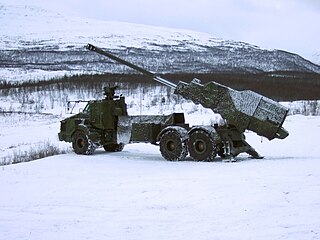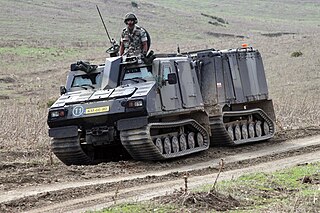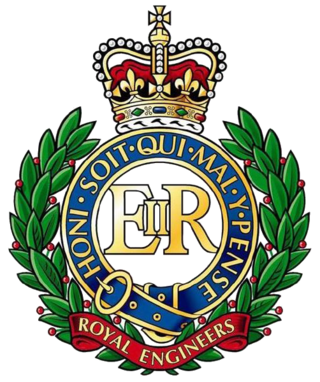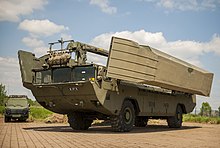
An armoured fighting vehicle or armored fighting vehicle (AFV) is an armed combat vehicle protected by armour, generally combining operational mobility with offensive and defensive capabilities. AFVs can be wheeled or tracked. Examples of AFVs are tanks, armoured cars, assault guns, self-propelled artilleries, infantry fighting vehicles (IFV), and armoured personnel carriers (APC).

A military engineering vehicle is a vehicle built for construction work or for the transportation of combat engineers on the battlefield. These vehicles may be modified civilian equipment or purpose-built military vehicles. The first appearance of such vehicles coincided with the appearance of the first tanks, these vehicles were modified Mark V tanks for bridging and mine clearance. Modern military engineering vehicles are expected to fulfill numerous roles such as; bulldozer, crane, grader, excavator, dump truck, breaching vehicle, bridging vehicle, military ferry, amphibious crossing vehicle, and combat engineer section carrier.

An amphibious vehicle is a vehicle that is a means of transport viable on land as well as on or under water. Amphibious vehicles include amphibious bicycles, ATVs, cars, buses, trucks, railway vehicles, combat vehicles and hovercraft.

A pontoon bridge, also known as a floating bridge, uses floats or shallow-draft boats to support a continuous deck for pedestrian and vehicle travel. The buoyancy of the supports limits the maximum load that they can carry.

The 79th Armoured Division was a specialist armoured division of the British Army created during the Second World War. The division was created as part of the preparations for the Normandy invasion on 6 June 1944, D-Day.

The FV180 Combat Engineer Tractor or C.E.T. is an amphibious specialist armoured vehicle formerly used by the British Army. A tracked, lightly armoured vehicle, with amphibious capability, the CET was used by Royal Engineers in ground preparation for bridge construction and towing activities in the front line of battle, such as digging vehicle fighting pits, constructing earthen barriers, repairing roads, recovery of disabled vehicles from water and other obstacles, preparing riverbanks for vehicle crossings and clearing obstacles.

The EFA or Engin de Franchissement de l'Avant is a field-deployable river crossing vehicle, used by combat engineers in the French Army. Unlike a bridge layer, which transports a bridge that is deployed off of the host vehicle, the EFA itself is a combined pontoon bridge and amphibious vehicle, enabling much more rapid redeployment of the bridge structure and an additional use as a ferry. When needed, multiple EFA's can be combined in a series to create a traditional pontoon bridge. It has been built since 1989 by Chaudronnerie et Forges d'Alsace (CEFA), located in Soultz-sous-Forêts in the Bas-Rhin.

The M60 Armored Vehicle Launched Bridge (AVLB) is an armored vehicle based on the M60 Patton main battle tank's hull and used for the launching and retrieval of a 60-foot (18 m) scissors-type bridge. The AVLB consists of three major sections: the launcher, the vehicle hull, and the bridge. The M60 AVLB or Armored Vehicle Launched Bridge was introduced in 1963. This combat engineer vehicle was developed by the US Army Engineer Research & Development Laboratories under contract with General Dynamics to replace the previous M48 AVLB. It was designed to launch bridge for tanks and other wheeled combat vehicles across trenches and water obstacles in combat conditions. A total of 400 armored bridge launchers and bridges were built. 125 M60 AVLBs of all variants were constructed.

An armoured vehicle-launched bridge (AVLB) is a combat support vehicle, sometimes regarded as a subtype of military engineering vehicle, designed to assist militaries in rapidly deploying tanks and other armoured fighting vehicles across gap-type obstacles, such as rivers. The AVLB is usually a tracked vehicle converted from a tank chassis to carry a folding metal bridge instead of weapons. The AVLB's job is to allow armoured or infantry units to cross craters, anti-tank ditches, blown bridges, railroad cuts, canals, rivers and ravines, when a river too deep for vehicles to wade through is reached, and no bridge is conveniently located, or sufficiently sturdy, a substantial concern when moving 60-ton tanks.

The Archer Artillery System, or Archer – FH77BW L52, or Artillerisystem 08, is a Swedish self-propelled howitzer system. The main piece of the system is a fully automated 155 mm L52 (52-calibre-long) gun-howitzer and a M151 Protector remote-controlled weapon station mounted on a modified 6×6 chassis of the Volvo A30D all-terrain articulated hauler. The crew and engine compartment is armoured and the cab is fitted with bullet and fragmentation-resistant windows. The system also includes an ammunition resupply vehicle, a support vehicle, BONUS submunitions and M982 Excalibur guided projectiles.

The BvS10 is a tracked articulated amphibious all-terrain armoured vehicle produced by BAE Systems Land Systems Hägglunds of Sweden. This vehicle, referred to as the All Terrain Vehicle (protected) - ATV(P) or Viking by the UK forces, was originally developed as a collaboration between industry - Hägglunds Vehicle AB - and the British Ministry of Defence (MoD) on behalf of the Royal Marines.

Floats are airtight hollow structures, similar to pressure vessels, designed to provide buoyancy in water. Their principal applications are in watercraft hulls, aircraft floats, floating piers, pontoon rhinos, pontoon causeways, and marine engineering applications such as salvage.

The Siebel ferry (Siebelfähre) was a shallow-draft catamaran landing craft operated by Germany's Wehrmacht during World War II. It served a variety of roles in the Mediterranean, Baltic and Black Seas as well as along the English Channel. They were originally developed for Operation Sea Lion in 1940, the cancelled German invasion of England. Siebel ferries continued performing after the war's end in 1945.

This is a list of bridging and trackway equipment used by the Royal Engineers of the British Army. For more equipment in use with the Royal Engineers, see Modern equipment of the British Army.

The 549th Engineers Light Pontoon Company was a combat engineer company of the United States Army during World War II. Operationally attached to the 1150th Engineer Combat Group, it served under XXI Corps of the Seventh Army in action in France and Germany in 1944 and 1945.

An Engineer Light Ponton Company was a combat engineer company of the United States Army that served with U.S. Army ground forces during World War II. It was primarily a highly mobile pontoon bridge construction unit, though it also provided both M2 assault boats and a selection of infantry support bridging, ferries, and rafts.
General Dynamics European Land Systems (GDLS) is an automotive and arms manufacturer spread across Europe, with a headquarter in Madrid, Spain. It is a business unit of General Dynamics which consolidated in one structure all European subsidiaries of GDLS.


















